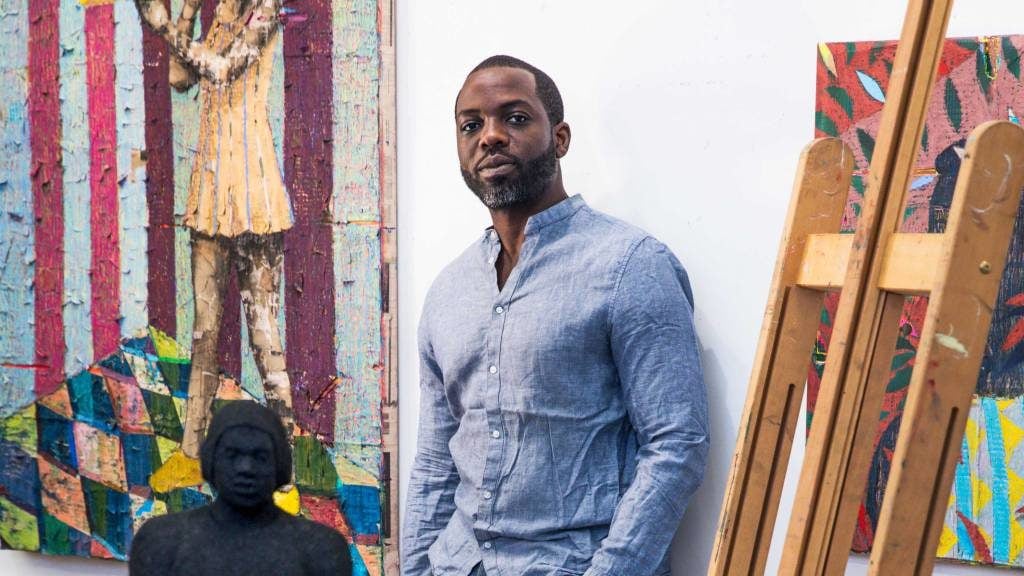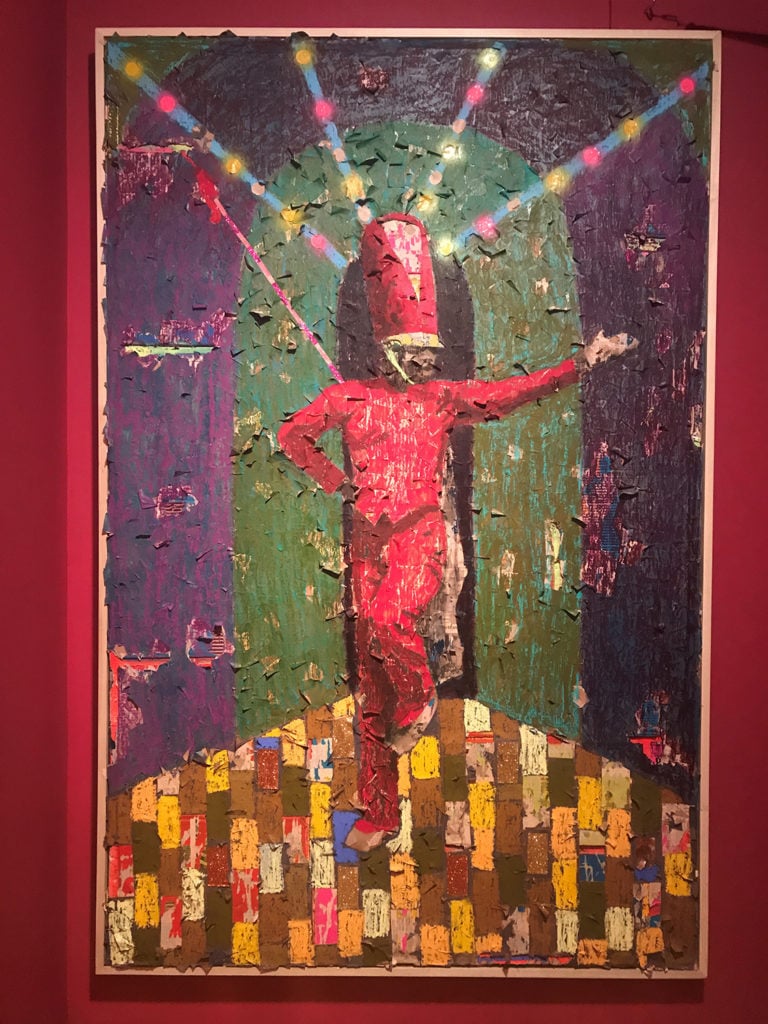On View
How Artist Derek Fordjour Turned Cardboard and Newspaper Into a Carnival Funhouse
The artist takes us behind the scenes of his show at the Sugar Hill Children’s Museum of Art & Storytelling.

The artist takes us behind the scenes of his show at the Sugar Hill Children’s Museum of Art & Storytelling.

Sarah Cascone

Ahead of his latest exhibition, artist Derek Fordjour spent a year in residence at the Harlem museum. He crafted a carnival-inspired dreamworld populated by marvels that blend the everyday with the fantastic: a Ferris wheel, tribal art figurines, a popcorn machine, and a velvet-flocked tricycle topped with a birthday cake done in tribute to Wayne Thiebaud. Those elements became the building blocks for “PARADE,” Fordjour’s show at Sugar Hill Children’s Museum of Art & Storytelling.
“Everything in the show was made here and onsite and just for the show,” Fordjour told artnet News during a studio visit.
Visitors weave their way through the narrow hallways of the funhouse-like installation: A glittering yellow brick road leads the way into a sculpture-filled corridor of childhood delights that culminates in a Narnia-inspired wardrobe, stocked with used shoes and clothing. One climbs through not to another world but to discover a haunting player piano and the sounds of Scott Joplin’s “The Entertainer.”
For this edition of “Origin Story,” in which we examine the backstory of an individual work of art, Fordjour walked us through the creation of The Drum Major, a painting of a triumphant figure in red which greets visitors at the entrance of the show.

Derek Fordjour’s The Drum Major (2017). Photo courtesy of Derek Fordjour.
How did you develop your painting technique?
It started because I had no money. I couldn’t afford paint, only newspaper and charcoal. The first works were just that. Eventually, I became much more elaborate and started working with corrugated cardboard.
I start with tiles of corrugated cardboard squares and rectangles, glued to canvas and covered in spray paint. We just lay out the pieces and then determine the spaces in between the pieces. We do a layer of papering on top, applying glue in a netting pattern, which is what allows for good removal. If you just smear on all the glue it will just be stuck. These little air bubbles between the layers create a way for me to get a knife in there and have things sort of pop off, which is how we end up with a beautiful surface.
Then I draw an image right on the paper, and color it with acrylic and spray paint. I cover it in newspaper again, and then with hundreds of very small pieces of archival masking paper. Using registration marks and a custom acetate stencil, the figure is graphed onto the new surface and the entire underpainting is reconstructed as a drawing in charcoal.
Through a series of cuts and tears, painted and drawn marks with spray paint, charcoal, acrylic, and oil pastel, the final surface alternately conceals and reveals underlying layers to create a rich, textured surface. There’s a relationship between the under-image and the top image.
I would have never thought of a process like this, but I think I really just love the payoff with the final surface that it has all that memory.
How much of the final product do you plan ahead of time, and how much evolves during the creation process?
It’s really just a process that grows out of making. I can’t say I’ve stepped back and thought about it because the more you make it, it just kind of happens. So it’s a relationship between the layers that makes it work.
There’s some kind of logic to it, I think that’s intuitive. The coloring and the spacing, it might be beyond language, honestly. It’s just very intuitive, the way I balance color.
When I’m on the top surface and I start ripping and tearing, I don’t always know what’s under there, exactly. And that’s like fun, and I respond to that—trying to build in some surprises and some improvisation.
Your paintings have a kind of worn, distressed look to them. What inspired that?
The reason I work this way or why I’m drawn to this kind of surface is a lot about my experiences with used things or worn things. So my parents are Ghanaian and when we were kids they would send our used clothes to Africa. We would get pictures back of our cousins wearing clothes we had 10 years ago, but they would be fresh, restyled as if they got the newest. Seeing an old thing become new again, the dignity of that, that’s one layer.
Also, I grew up in Memphis, Tennessee, where there was a lot of white flight. There would be these white neighborhoods, and then black families would move in, and then the white families would move out.
I’m really attracted to that notion of our institutions and our homes having that kind of used, worn, quality but still trying to have dignity about it, and make it something new. That kind of wear and tear, that’s kind of what it’s about.
“PARADE: Derek Fordjour” is on view at the Sugar Hill Children’s Museum of Art & Storytelling, 898 St. Nicholas Avenue at West 155th Street, July 27, 2017–January 18, 2018.